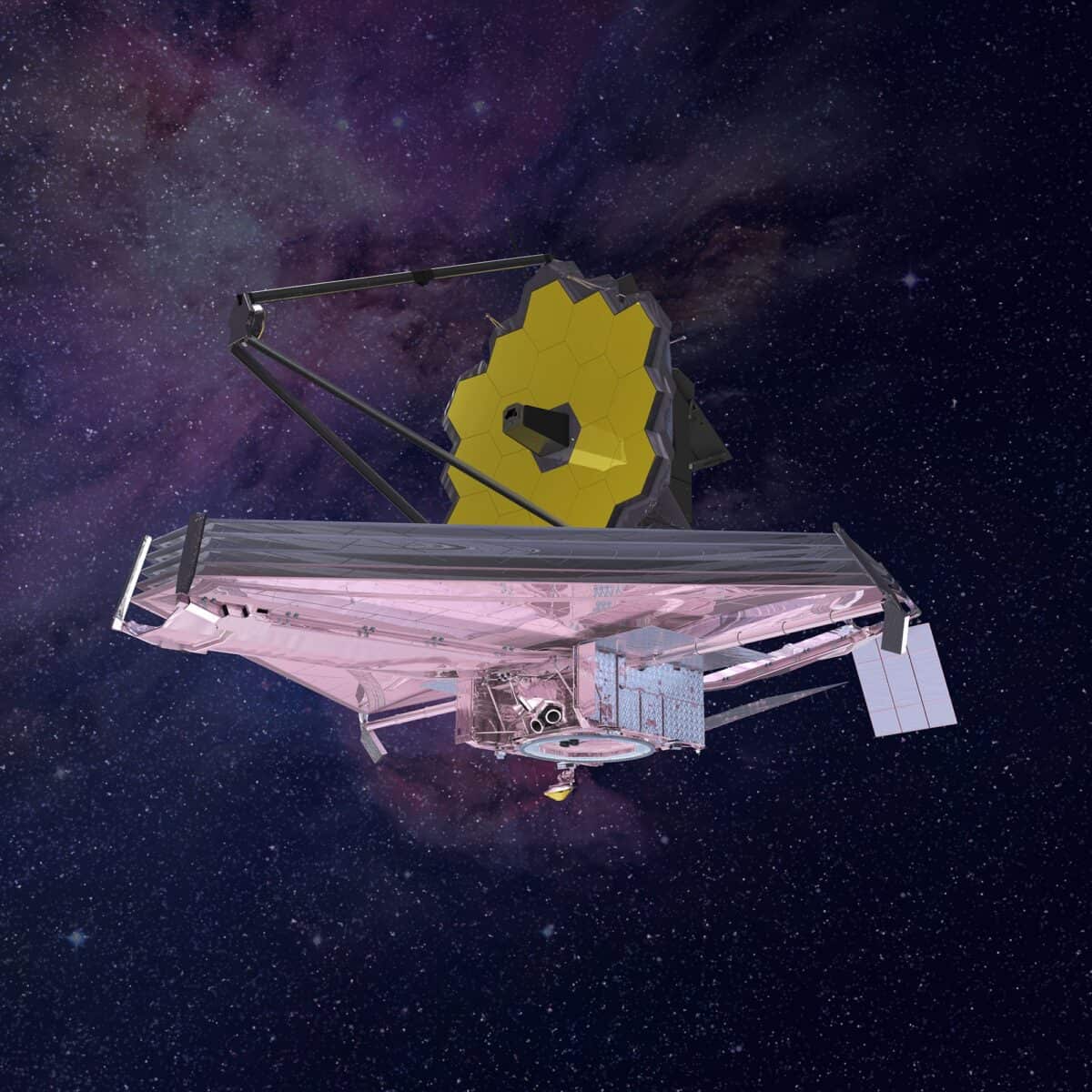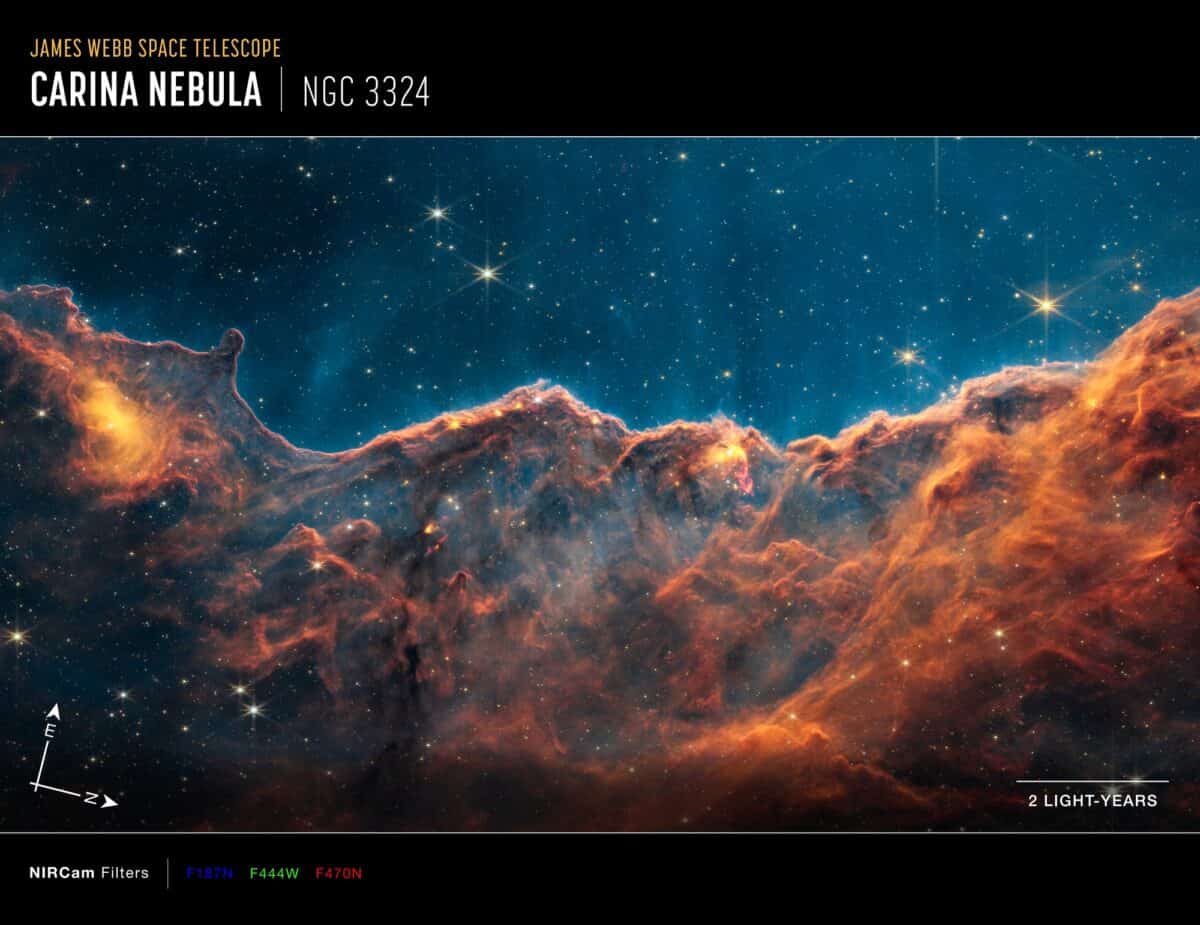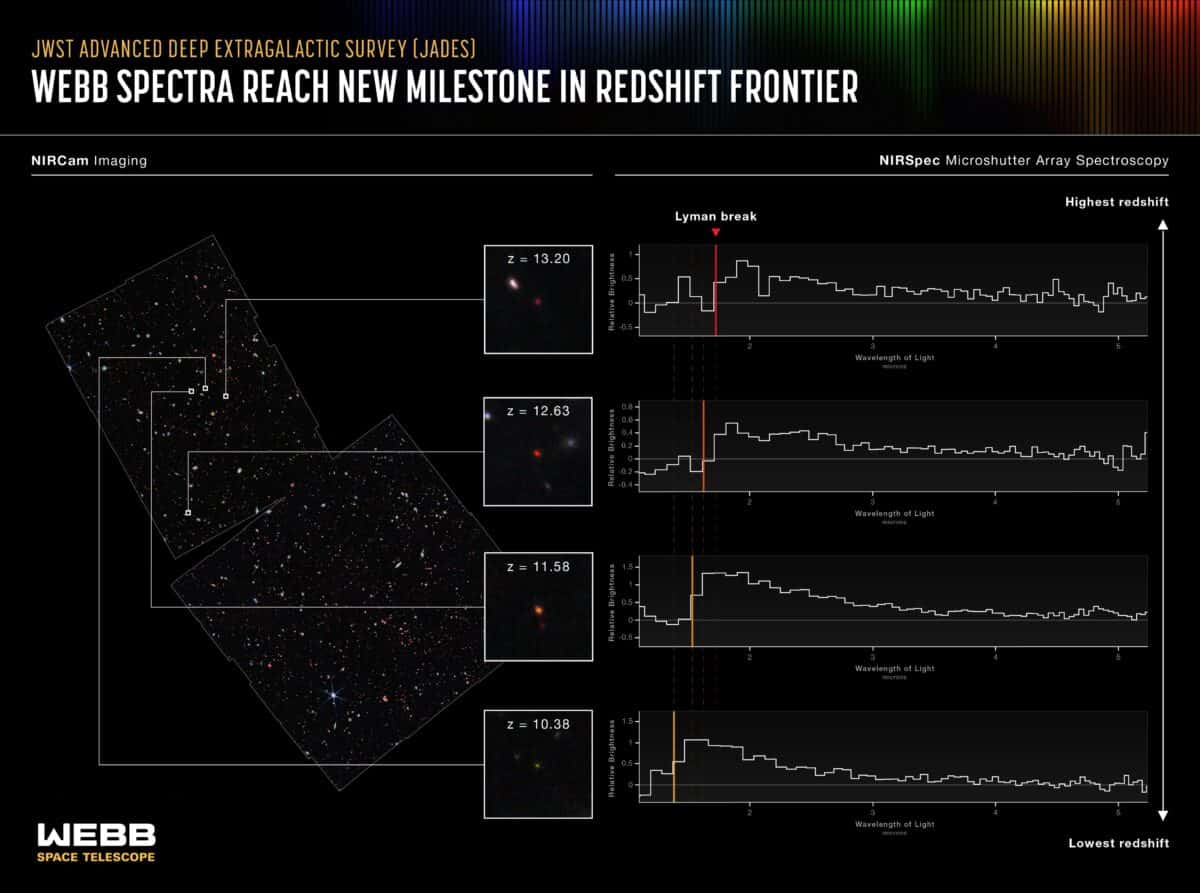Over the past several months, NASA, ESA, and the CSA have released eye-popping images revealing the oldest galaxies in the universe. The James Webb Space Telescope (JWST) has only been in operation for roughly a year and a half, but what a year and a half!
Astronomers recently announced that they had “unambiguously detected” four very distant and very old galaxies. The four galaxies are believed to have been formed approximately thirteen billion years ago. When the four galaxies were formed, the universe was somewhere between 300 and 500 million years old.
Long-held beliefs about how galaxies are formed have been called into question as this new data about the oldest galaxies in the universe comes to light. Keep reading to learn more about the James Webb’s latest discoveries.
The James Webb Space Telescope
The James Webb Space Telescope is currently the largest telescope in space. It is currently orbiting approximately 1.5 million km (or around 932,000 miles) from Earth. The telescope was launched on December 25, 2021, and the mission is expected to last between 5-10 years. The JWST has four primary mission objectives:
- Peer back through the dust and clouds of space and observe space as it was 13.5 billion years ago. It’s believed that the first stars and galaxies were formed right after the big bang.
- Use infrared equipment to see through space dust and debris. The optical properties of previous telescopes have primarily focused on the visible wavelength spectrum.
- Collect data and images to learn how galaxies form over millions and billions of years.
- Study planets that reside outside our own galaxy. Do other planets like Earth have similar atmospheres?
Let’s take an in-depth look into how the James Webb telescope allows scientists to observe space as it was billions of years ago.

.
It is expected to be in orbit for up to 10 years.
©NASA, ESA, Northrop Grumman – Original / License
Light is a Time Machine
The speed of light is 186,282 miles per second and this speed is constant. It doesn’t matter if the light source is stationary or whether it is coming from a moving source. If you’re riding your bike down the road, the light from your headlamp travels at the same rate as the light from your buddy’s headlamp, even if he is waiting by the side of the road for you to catch up.
Once we understand that light is moving at a constant rate of speed, we can think of the light as a time machine. It takes about 8 minutes and twenty seconds for sunlight to travel the 93,000,000 miles to Earth. This means that if you look at the sun, you would see the sun as it looked about eight minutes ago.
The same principle applies to other objects in space. On average, it takes about 45 minutes for light to travel from Jupiter to Earth. So, whatever we’re seeing through our telescopes occurred on Jupiter 45 minutes ago. Light from the closest star system, Alpha Centauri, takes approximately four years to reach Earth, giving us a glimpse of the system as it was four years previously. Now let’s take this a step further.
Take a Look Back in Time with the James Webb Telescope
When scientists view images of distant galaxies through the James Webb telescope, they’re seeing images of the galaxies as they appeared billions of years ago. The information that we’re collecting, observing, and analyzing is data that are billions of years old. If we could snap our fingers and instantaneously travel to these distant locations, we might find that things look different today than they looked ten or twelve billion years ago.
The James Webb’s near infrared camera (NIRCam) is one of the instruments that makes this possible. The NIRCam detects light that is not visible to the naked eye, covering the infrared wavelength range 0.6 to 5 microns. It can detect light from stars and galaxies that are just beginning to form, stars in nearby galaxies, and young stars or other objects in our own galaxy.
The James Webb’s infrared instruments also enable astronomers to identify carbon-based chemicals called polycyclic aromatic hydrocarbons (PAHs). PAHs are complex organic molecules that are thought to be vital in the formation of new stars and planets. The infrared emissions of PAHs can help determine star formation rate and further our understanding of galaxy evolution.

©Megan Reiter (Rice University), NASA, ESA, CSA, STScI, Joseph DePasquale (STScI), Anton M. Koekemoer (STScI) – Original / License
How Do Scientists Know the Age of a Galaxy?
How do scientists know the approximate age of a galaxy? Is there a rule book? Actually, there are a few clues for astronomers to look at to help them determine the age of a galaxy. One way is to look for the oldest stars in the galaxy. Another way is to measure the “Hubble constant.” The Hubble constant (H0) measures the current expansion rate of the Universe. By determining how fast an object is moving away from Earth, we can figure out its distance.
The Doppler Effect, Redshifting, and Blueshifting
The wavelength of light contracts or stretches as it travels through space. As the wavelength stretches or contracts, we call it “redshifting” or “blueshifting.” These are examples of the Doppler Effect.
As objects move away from us, the sound or light waves coming from the object are stretched out. This causes sounds to be lower pitched and light waves move closer to the red end of the electromagnetic spectrum, where light has a longer wavelength. When it concerns light waves, this is called redshift.
As objects move towards us, the sound and light waves get squeezed together. This causes sounds to be higher pitched and light waves shift to the blue end of the electromagnetic spectrum, where light has a shorter wavelength. This is what is known as blueshift.
If an object is traveling towards us, its light will appear blueshifted, but if it is traveling away from us, the light will be appear redshifted. Consequently, the further away an object is, the more it will be redshifted.
The Oldest Galaxies in the Universe
A recently published paper in Nature has identified four galaxies that are the oldest galaxies ever detected. With ten days of data collection from the NIRCam and 28 hours of data collection from the NIRSpec instrument, scientists were able to measure each galaxy’s redshift. They placed the age of the galaxies somewhere between 320 million to 350 million years after the universe’s formation, AKA the Big Bang. The Galaxies have been identified as JADES-GS-z10-0, JADES-GS-z11-0, JADES-GS-z12-0, and JADES-GS-z13-0.
The James Webb Space Telescope Advanced Deep Extragalactic Survey = JADES. The JADES project is a collaboration between the Near Infrared Camera (NIRCam) team and the Near-Infrared Spectrograph (NIRSpec) teams. The teams will work together to collect and summarize data from approximately 800 hours of telescope spectroscopy data collection from thousands of galaxies.
Z-Value
The Z value is the calculated redshift value. The redshift value lets us know how long the light has been traveling, e.g. how long ago the light left its origin point, and the distance between us and the light source today.
| Z Value | Light Traveling Time (Years) | Distance Away (Light Years) |
|---|---|---|
| 0.0000715 | 1 million | 1 million |
| 5 | 12.5 billion | 22.3 billion |
| 10 | 13.2 billion | 26.6 billion |
| 11 | 13.4 billion | 32 billion |
| 12 | 13.6 billion | 33.2 billion |
| 13 | 13.6 billion | 33.6 billion |
In the case of JADES-GS-z10-0, the name given to the galaxy itself lets us know that the JADES project studied the galaxy and identified the age of the galaxy at approximately 13.2 billion years old. It’s exciting to think that the light we’re examining in JADES-GS-z10-0 left the distant galaxy 13.2 billion years ago. Since the universe has continued to expand, that same galaxy is 26.6 billion light years away!
Redshift Data
The image below shows the portion of the sky that James Webb examined. The image on the right displays the redshift values for the four detected galaxies. The redshift value allows scientists to estimate how long it took for the light from the galaxy to reach the telescope. It took approximately 13.6 billion years for the light to travel from the galaxies to the telescope observation location.

©NASA, ESA, CSA, M. Zamani (ESA/Webb), Leah Hustak (STScI), Brant Robertson (UC Santa Cruz), S. Tacchella (Cambridge), E. Curtis-Lake (UOH), S. Carniani (Scuola Normale Superiore), JADES Collaboration – Original / License
Not content to accept the results from redshifting, scientists also studied the chemical composition of the galaxies. The primary elements present after the Big Bang are helium and hydrogen. Heavier elements like oxygen, nitrogen, and carbon haven’t formed yet. The presence of hydrogen and helium and the lack of heavier elements was truly a eureka moment for scientists. The combination of spectra results and redshifting indicated that the galaxies were truly “young” galaxies.
Data Collection
It’s not easy to take a long exposure photograph. Our hands shake, the wind blows, what have you. We end up with blurry pictures. So we use tripods to capture our photographs when the lighting is dim, or it’s sunset, or the weather won’t cooperate. On our longest exposures (not astronomy photos!), we’re working in the neighborhood of 1/50th of a second. The galaxies that the James Webb is observing are billions of light years away. The spectra collected aren’t very bright, so the NIRCam uses very long exposure times to collect data from faraway galaxies.
A mere nine hours to a maximum of twenty-eight hours with the James Webb camera shutter fully open was used to collect data from the oldest galaxies in the universe.
The table below shows the shutter time the NIRCam used to collect data from the galaxies. We have blurry images from night photography with a shutter speed of 1 second! Can you imagine an open shutter for nine to twenty-eight hours?
| Galaxy | JWST Shutter Time |
|---|---|
| JADES-GS-z10-0 | ≅ 18.5 hours |
| JADES-GS-z11-0 | ≅ 28 hours |
| JADES-GS-z12-0 | ≅ 18.5 hours |
| JADES-GS-z13-0 | ≅ 9.3 hours |
Just like our environment impacts the quality of our images, it also affects the quality of the data the James Webb collects. Vibration from other components, heat from the sun and other instruments on the telescope, plus the cold temperatures of space must be factored into the instrument’s design. It’s a mind-blowing feat of engineering and science that it’s all working together.
What Comes Next?
Not all scientists believe that JADES-GS-z10-0, JADES-GS-z11-0, JADES-GS-z12-0, and JADES-GS-z13-0 are the oldest galaxies. A brand peer-reviewed new study from the University of Texas suggests that the James Webb has misidentified four Dark Stars as the oldest Galaxies. Dark s are powered by dark matter. Dark stars are primarily composed of helium and hydrogen and form in the center of proto-galaxies. Sounds familiar! The study suggests that the data set JADES is examining is too small and that to make the kind of conclusions reached, JADES would need to collect the spectra for approximately one year, not just one day. (Better get a bigger SDD!)
The James Webb will examine the area known as the Hubble Ultra Deep Field later in 2023. At the moment, the telescope is exploring the Hubble Deep Field. Given the short time that the James Webb has been collecting data, there’s a possibility that even “older” galaxies will be discovered soon!